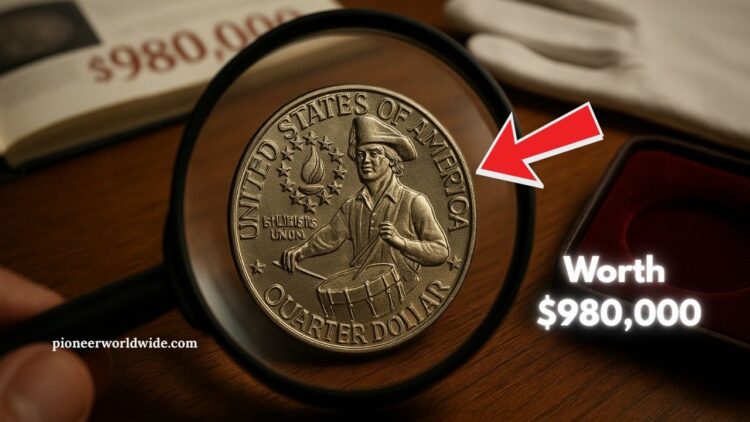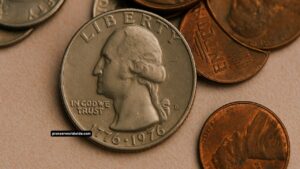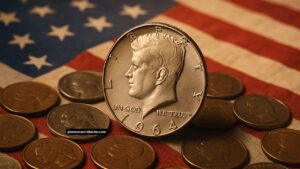If you find a 1976 Bicentennial quarter featuring the Colonial drummer—also known as the “Drummer Boy” quarter—you might just have a rare treasure hiding in your pocket.
One exceptional example recently fetched an astonishing $980,000 at auction—proof that even common-looking coins can hold extraordinary value.
What Is the 1976 Drummer Boy Quarter?
Issued to commemorate the 200th anniversary of American independence, the 1976 quarter replaced the traditional bald eagle on the reverse with a Colonial drummer boy, along with a dual date of “1776–1976.” Over 1.6 billion were minted across Philadelphia (no mint mark), Denver (“D”), and San Francisco (“S”).
Despite the massive mintages, a few rare variants—particularly those with silver content, proof quality, and mint errors—have emerged as extremely valuable collector items.
The $980,000 Coin – What Makes It So Valuable?
The quarter that sold for $980K isn’t your ordinary collector’s piece. Experts cite several key features:
- Proof strike on a 40% silver planchet produced only at the San Francisco Mint.
- Likely graded PR70 Deep Cameo, a perfect score on the Sheldon grading scale.
- Possible double die obverse error, enhancing rarity and collector demand.
This combination of scarcity, grade perfection, and historical significance propelled its value into the six-figure range.
Valuable Versus Common: Spotting the Rare Ones
While most Bicentennial quarters remain worth only 25 cents, several characteristics can indicate a valuable variant:
| Feature | What to Look For |
|---|---|
| Mint Mark | “S” indicates San Francisco—proof or silver versions preferred. |
| Silver Content | Silver coins feel heavier and sound different when dropped. |
| Proof Finish | Mirror-like surfaces with frosted details—look for a high contrast cameo effect. |
| Errors/Varieties | Double-die obverse, off-center strikes, missing clad layers, die cracks. |
| Grading & Condition | Uncirculated or flawless grading (MS70 or PR70) greatly boosts value. |
For example, a high-grade silver-proof quarter with PR70 Deep Cameo and a double die could fetch hundreds of thousands, while clad errors in lower grades still reach several thousands.
Estimated Value Ranges
| Coin Type | Typical Characteristics | Estimated Value |
|---|---|---|
| Proof, 40% silver, PR70 DCAM, double die | Silver, perfect grade, collector error | $500,000–$1,000,000+ |
| Silver proof (no errors), PR69–70 | High-grade silver proof | $10,000–$25,000 |
| Clad proof, PR69+, Type II reverse | No errors, mirror cameo finish | $500–$2,500 |
| Clad business strike, PR70+ error | Rare mint error in perfect grade | $1,000–$15,000 |
| Circulating clad coin, full drum lines | High condition, no errors | $150–$9,000 |
How to Check and Protect Your Coin
If you suspect you own a valuable 1976 Drummer Boy quarter, follow these steps:
- Handle with care—do not clean or polish the coin.
- Check for mint mark and silver sheen—look under Washington’s neck.
- Inspect closely for errors using a magnifier.
- Submit for grading with a reputable service like PCGS or NGC.
- Consult numismatic experts or attend coin shows for valuations.
- Choose the right platform for selling—auction houses or certified dealers.
Why These Coins Still Made Headlines
Rare Bicentennial quarters continue to astonish collectors. Another high-grade silver quarter sold for nearly $1 million, and even clad proof coins with substantial errors reach six-figure prices. These findings serve as reminders that wealth can be hidden in everyday change.
What began as a commemorative quarter in your pocket could now be a nearly million-dollar treasure. The remarkable sale of a $980,000 Drummer Boy quarter underscores the value that lies in rare mint conditions, silver proof strikes, and minting errors.
So next time you find a 1976 quarter—or multiple—don’t just spend it. Check for mint mark, silver ally, and proof finish. If it looks special, consider grading it. You might be holding a piece of American history worth a small fortune.
FAQs
Are most 1976 quarters worthless?
Yes. The vast majority are standard clad coins worth only face value. Only rare proof, silver, or error coins are valuable.
How can I tell if mine is silver?
Silver planchets feel heavier and have a solid color on the edge. Clad coins have a visible copper stripe.
Where can I get it graded?
Submit your coin to PCGS, NGC, or ANACS for professional grading. Do not clean or damage the coin beforehand.




